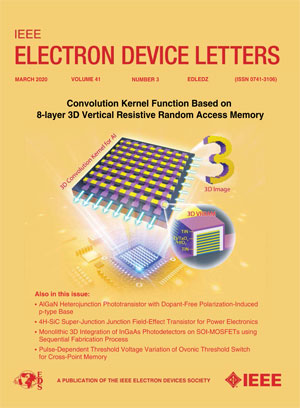磁隧道结顶部自旋-轨道-转矩开关的原位效率量化
IF 4.5
2区 工程技术
Q2 ENGINEERING, ELECTRICAL & ELECTRONIC
引用次数: 0
摘要
自旋轨道转矩(SOT)磁随机存取存储器(MRAM)被认为是一种很有前途的解决方案,可以克服“存储墙”问题,并引领更好的计算方式。然而,具有垂直磁各向异性(PMA)的传统顶钉式sot - mram在制造过程中总是存在侧壁再沉积和过蚀刻问题,并且隧道磁电阻低于底钉式。为了解决这些问题,我们报道了一种新型的带有PMA和底部钉住磁基准层的SOT- mram,通过电流流过SOT顶部通道,在面内磁场的帮助下实现SOT开关。这种器件被称为top-SOT pma -磁隧道结(pMTJ),在10~ 10 μ s脉冲宽度下,其临界开关电流密度约为40 MA/cm2。此外,我们直接表征了MRAM器件中的SOT效率,并证明了顶部Pt电极沉积在top-SOT- pmtj中是有效的SOT源,启发了top-SOT- pmtj堆叠和制造工艺的灵活设计。所提出的后端兼容制造结构有望用于高性能sot - mram的批量生产。本文章由计算机程序翻译,如有差异,请以英文原文为准。
Top Spin-Orbit-Torque Switching of Magnetic Tunnel Junction With In-Situ Efficiency Quantification
Spin orbit torque (SOT) magnetic random access memory (MRAM) has been regarded as a promising solution to overcome the ‘memory wall’ problem and led the way to better computing. However, conventional top-pinned SOT-MRAMs with perpendicular magnetic anisotropy (PMA) always suffer from the sidewall redeposition and over-etching problem during fabrications, as well as lower tunneling magnetoresistance than the bottom-pinned one. To address these problems, we reported a novel SOT-MRAM with PMA and bottom-pinned magnetic reference layer, realizing SOT switching by current flowing through top SOT channel with assistance of in-plane magnetic field. Such device, known as top-SOT PMA-magnetic tunnel junction (pMTJ), presents critical switching current density around 40 MA/cm2 at $10~\mu $ s pulse width. In addition, we characterized the SOT efficiency directly in MRAM device and post-deposited top Pt electrode in top-SOT-pMTJ is demonstrated to be effective SOT source, inspiring flexible design of top-SOT-pMTJ stacks and fabrication process. The proposed structure with back-end-of-line compatible fabrication is anticipated to the mass production of high-performance SOT-MRAMs.
求助全文
通过发布文献求助,成功后即可免费获取论文全文。
去求助
来源期刊

IEEE Electron Device Letters
工程技术-工程:电子与电气
CiteScore
8.20
自引率
10.20%
发文量
551
审稿时长
1.4 months
期刊介绍:
IEEE Electron Device Letters publishes original and significant contributions relating to the theory, modeling, design, performance and reliability of electron and ion integrated circuit devices and interconnects, involving insulators, metals, organic materials, micro-plasmas, semiconductors, quantum-effect structures, vacuum devices, and emerging materials with applications in bioelectronics, biomedical electronics, computation, communications, displays, microelectromechanics, imaging, micro-actuators, nanoelectronics, optoelectronics, photovoltaics, power ICs and micro-sensors.
 求助内容:
求助内容: 应助结果提醒方式:
应助结果提醒方式:


